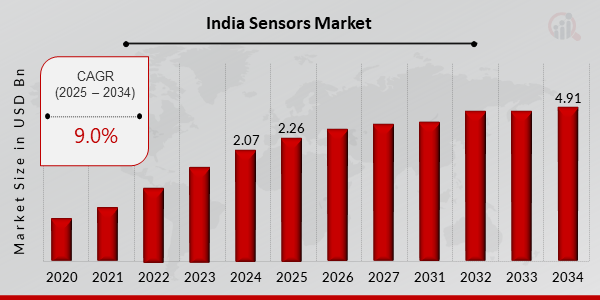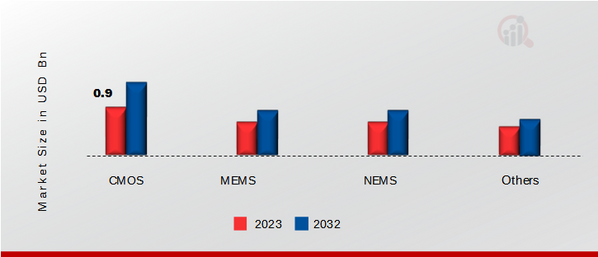India Sensors Market Overview:
India Sensors Market Size was valued at USD 2.07 Billion in 2024. The sensor market industry is projected to grow from USD 2.26 Billion in 2025 to USD 4.91 Billion by 2034, exhibiting a compound annual growth rate (CAGR) of 9.0% during the forecast period (2025 - 2034). The growing demand for automation and the widespread adoption of devices such as tablets, PCs, smartphones, and smartwatches, coupled with rising automotive sales and advancements in consumer electronics technology, are the main market drivers anticipated to propel the Sensors market in the United States.

Source: Secondary Research, Primary Research, MRFR Database and Analyst Review
India Sensors Market Trends
-
An increase in automation in various verticals and increasing emphasis on safety solutions in the automotive industry is driving the market growth
Factory automation and the implementation of Industry 4.0 heavily rely on industrial sensors. These sensors, including motion, environmental, and vibration sensors, play a critical role in monitoring equipment health, covering aspects like linear or angular positioning, tilt sensing, leveling, shock detection, and fall detection. India's industrial sectors are poised for economic and demographic expansion, supporting both domestic interests and export opportunities, which are anticipated to grow significantly. As part of the 'Make in India' initiative, the Indian government is prioritizing automobile manufacturing. According to the Auto Mission Plan (AMP) 2016-26, the passenger car market is projected to triple to 9.4 million units by 2026, leading to an increased utilization of sensors in the region. Companies are also expanding their operations to reinforce their positions in their respective markets. For instance, Gurgaon-based auto component supplier Minda Industries partnered with two Chinese subsidiaries of a US-based company, Sensata, to acquire wheel speed sensors for portfolio enhancement. According to Invest India, the automobile sector has received a cumulative equity FDI inflow of approximately US$ 35.40 billion between April 2000 and September 2023. India is on track to become the largest electric vehicle (EV) market by 2030, with a total investment opportunity exceeding US$ 200 billion over the next 8-10 years. Moreover, the demand for automation is expanding in government-designated essential industries such as food and beverage, manufacturing, and pharmaceuticals, driven by labor shortages and the need for remote monitoring and operations. This surge in automation demand has led to increased requirements for various types of sensors.
The demand for Advanced Driver Assistance Systems (ADAS) is expected to surge in the foreseeable future, primarily propelled by regulatory revisions focusing on safety applications aimed at protecting drivers and preventing accidents. Additionally, there is a growing consumer interest in ADAS as people recognize the potential life-saving and comfort-related benefits it offers. In September 2018, the Union Minister for Road and Highway Transport announced plans to mandate ADAS in all new vehicles (including heavy-duty) by 2022, emphasizing the government's commitment to road safety. In 2018, India witnessed 467,044 road accidents, marking an increase from 464,910 in 2017. Consequently, it is anticipated that more automakers will integrate ADAS into their vehicles shortly. These systems, such as parking assistance, blind spot recognition, and lane departure warning, are expected to contribute significantly to reducing the number of accidents on the road. Therefore, the market is expanding due to the Increase in Automation in various verticals and the Increasing Emphasis on Safety Solutions in the Automotive Industry. Thus, driving the Sensors market revenue.
India Sensors Market Segment Insights:
Sensors Type Insights
The India Sensors market segmentation, based on product, includes Radar Sensor, Optical Sensor, Biosensor, Touch Sensor, Image Sensor, Pressure Sensor, Temperature Sensor, Proximity & Displacement Sensor, Level Sensor, Motion & Position Sensor, Humidity Sensor, Accelerometer & Speed Sensor, and Others. The image sensor segment dominated the market mostly. The rising usage of image sensors is primarily driven by the increasing popularity of smartphones and other portable electronic devices equipped with built-in cameras. As the digital camera industry continues to evolve, new features and advancements in image quality are continually being introduced. Consumers and professionals alike are increasingly seeking higher resolution, improved low-light performance, and faster focusing speeds. Image sensor technology plays a crucial role in meeting these demands by capturing and processing high-quality images.
Sensors Technology Insights
The India Sensors market segmentation, based on Technology, includes CMOS, MEMS, NEMS, and Others. The CMOS category generated the most income. A complementary metal oxide semiconductor (CMOS) image sensor comprises a photodiode and a CMOS transistor switch for each pixel, enabling individual amplification of pixel signals. CMOS image sensors are more cost-effective to produce compared to CCD image sensors, as existing semiconductor manufacturing equipment can be repurposed for their production. Unlike CCD sensors, which utilize high-voltage analog circuits, CMOS sensors employ smaller digital circuitry that consumes less power and is theoretically immune to smear (vertical white streaks in images captured under bright light) and blooming (image corruption such as white spots).
Figure 1: India Sensors Market, by Technology, 2023 & 2032 (USD Billion)

Source: Secondary Research, Primary Research, MRFR Database and Analyst Review
Sensors End User Industry Insights
The India Sensors market segmentation, based on distribution channel, includes Electronics, IT & Telecom, Automotive, Industrial, Aerospace & Defense, Healthcare, and Others. The automotive category generated the most income. The demand for Advanced Driver Assistance Systems (ADAS) is anticipated to experience significant growth in the foreseeable future, primarily driven by regulatory reforms aimed at enhancing safety measures to protect drivers and reduce accidents. Moreover, consumer interest in ADAS is on the rise as people become more aware of the potential life-saving and comfort-enhancing features it offers. In September 2018, the Union Minister for Road and Highway Transport announced the government's efforts to introduce a mandate requiring ADAS in all new vehicles, including Heavy-Duty vehicles, by 2022. According to a report by the Ministry of Road Transport and Highways, a total of 461,312 road accidents were reported by States and Union Territories (UTs) during the calendar year 2022, resulting in 168,491 fatalities and injuries to 443,366 individuals. This represents an increase of 11.9% in accidents, 9.4% in fatalities, and 15.3% in injuries compared to the previous year. Consequently, it is expected that several more auto brands will begin offering ADAS features on their vehicles shortly, particularly those related to parking assistance, blind spot detection, lane departure warning, etc., which are aimed at reducing the number of accidents. The introduction of these systems is poised to drive the automotive sensors market in the country.
Sensors Country Insights
India's industrial sector, renowned as a global manufacturing hub, is experiencing rapid expansion. According to the Economic Survey 2022-23 presented by the Union Minister for Finance & Corporate Affairs, the Overall Gross Value Added (GVA) by the Industrial Sector grew by 3.7 percent in the first half of FY23, surpassing the average growth rate of 2.8 percent recorded in the previous decade's first half. Moreover, the Foreign Direct Investment (FDI) inflow surged to US$ 21.3 billion in FY22 from US$ 12.1 billion in FY21, attributed to the pandemic-driven expansionary policies of advanced economies, which led to a boost in global liquidity. In the realm of industrial automation, process control, robotics, and equipment, sensors play a pivotal role. As India's manufacturing and industrial sectors continue to evolve, the demand for sensors to monitor and manage various operations and equipment is on the rise. Furthermore, India has been actively investing in the development of Internet of Things (IoT) technology and smart city initiatives. Under the Smart City Mission, 5,005 projects worth ₹92,766 crore have been completed as of December 12, 2022, with an additional 2,737 projects worth ₹88,796 crore in advanced stages of implementation.
India Sensors Key Market Players & Competitive Insights
Leading market players are investing heavily in research and development to expand their product lines, which will help the Sensors market, grow even more. Market participants are also undertaking a variety of strategic activities to expand their footprint, with important market developments including new product launches, contractual agreements, mergers and acquisitions, higher investments, and collaboration with other organizations. To expand and survive in a more competitive and rising market climate, the Sensors industry must offer cost-effective items.
Major players in the Sensors market are attempting to increase market demand by investing in research and development operations includes STMicroelectronics Private Limited, 3M India Limited, Texas Instruments (India) Private Limited, Freescale Semiconductor India Private Limited, Murata Electronics (India) Private Limited, Honeywell Automation India Private Limited, TE Connectivity India Private Limited, Alps Electric (India) Private Limited, Semtech Advanced Systems India Private Limited, Cognex Sensors India Private Limited.
Key Companies in the Sensors market include
Sensors Industry Developments
October 2021: Vishay Intertechnology's optoelectronics group unveiled a new AEC-Q100 certified ambient light sensor tailored for automotive and consumer applications requiring heightened sensitivity to detect light passing through opaque cover materials. The Vishay Semiconductors VEML6031X00 boasts high-sensitivity photodiodes, low-noise amplifiers, 16-bit ADCs, and infrared (IR) channels, all encapsulated in a compact 2.67mmx2.45mm surface mount package with a slim 0.6mm profile.
July 2021: The Digital University Kerala (DUK) collaborated with the Centre for Materials for Electronics Technology (C-MET) to establish India's inaugural Centre of Excellence in Intelligent Internet of Things (IoT) sensors near Kochi. The Union Ministry of Electronics and Information Technology (MeitY) and the state IT department joined forces to establish this Center of Excellence (CoE).
India Sensors Market Segmentation:
Sensors Type Outlook
Sensors Technology Outlook
Sensors End User Industry Outlook
| Report Attribute/Metric |
Details |
| Market Size 2024 |
USD 2.07 Billion |
| Market Size 2025 |
USD 2.26 Billion |
| Market Size 2034 |
USD 4.91 Billion |
| Compound Annual Growth Rate (CAGR) |
9.0% (2025-2034) |
| Base Year |
2024 |
| Market Forecast Period |
2025-2034 |
| Historical Data |
2020- 2023 |
| Market Forecast Units |
Value (USD Billion) |
| Report Coverage |
Revenue Forecast, Market Competitive Landscape, Growth Factors, and Trends |
| Segments Covered |
Type, Technology, End-User Industry, and Region |
| Countries Covered |
India |
| Key Companies Profiled |
STMicroelectronics Private Limited, 3M India Limited, Texas Instruments (India) Private Limited, Freescale Semiconductor India Private Limited, Murata Electronics (India) Private Limited, Honeywell Automation India Private Limited, TE Connectivity India Private Limited, Alps Electric (India) Private Limited, Semtech Advanced Systems India Private Limited, Cognex Sensors India Private Limited |
| Key Market Opportunities |
Increasing adoption across healthcare and biomedical sectors |
| Key Market Dynamics |
The expansion of the automotive industry The development of smart homes and smart cities |
Frequently Asked Questions (FAQ) :
The India Sensors market size was valued at USD 2.07 Billion in 2024.
The market is projected to grow at a CAGR of 9.0% during the forecast period, 2025-2034.
The key players in the market are STMicroelectronics Private Limited, 3M India Limited, Texas Instruments (India) Private Limited, Freescale Semiconductor India Private Limited, Murata Electronics (India) Private Limited, Honeywell Automation India Private Limited, TE Connectivity India Private Limited, Alps Electric (India) Private Limited, Semtech Advanced Systems India Private Limited, Cognex Sensors India Private Limited, and others.
The Image Sensor category dominated the market in 2023.
The Automotive category had the largest share of the market.
















